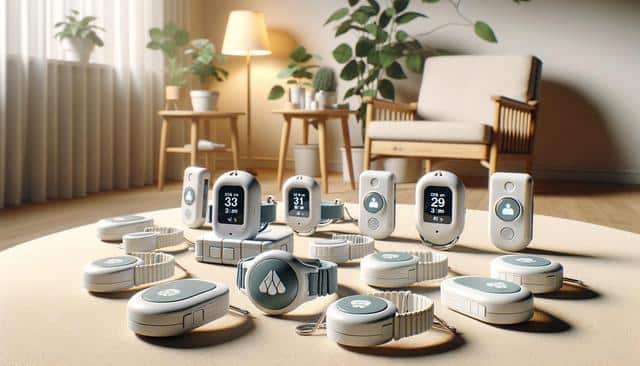
Staying Safe at Home: How Fall Detection Devices Support Senior Independence
Why Fall Detection Matters for Seniors
As people age, the risk of falling increases due to various factors such as decreased mobility, poor balance, or medical conditions. For older adults, a fall can result in serious injuries, long-term recovery challenges, or even a loss of independence. Fall detection devices have emerged as a valuable tool to help mitigate this risk, providing both seniors and their families with peace of mind. These devices are designed to automatically detect a fall and send an alert to caregivers or emergency services, ensuring help is dispatched quickly without relying on the wearer to call for assistance.
Fall-related incidents are a leading cause of injury among seniors, often resulting in hip fractures, head trauma, or hospitalization. The prompt response enabled by fall detection tools can significantly reduce the severity of these outcomes. In many cases, a faster response can mean the difference between a short-term recovery and long-term health complications.
For seniors who live alone, having a fall detection system in place can allow them to maintain their independence while still having a safety net in case of emergencies. It also gives family members reassurance, knowing that their loved one is protected even when no one else is around.
How Fall Detection Devices Work
Fall detection devices use advanced sensors and algorithms to monitor movement and identify sudden changes in motion that may indicate a fall. These devices are typically worn on the body—commonly on the wrist, neck, or belt—and can automatically send alerts if a fall is detected. Some models also allow users to manually press a button to call for help, adding a layer of control in non-emergency situations.
The technology behind these devices often includes:
- Accelerometers and gyroscopes to detect rapid changes in position or impact
- GPS tracking to pinpoint the wearer’s location in case of emergency
- Two-way communication to speak directly with a response center
- Mobile connectivity to send alerts to caregivers or emergency services
Most modern fall detectors are compatible with mobile apps, making it easy for family members to stay informed. These apps can provide real-time updates, track daily activity, and even detect near-falls, helping users and caregivers take preventive measures before a serious incident occurs.
Choosing a Fall Detection Device
When selecting a fall detection device for yourself or a loved one, several factors should be considered to ensure it meets individual needs. Not all devices are created equal, and features can vary widely from one product to another.
Key considerations include:
- Wearability: Devices should be comfortable and easy to wear throughout the day
- Battery life: Long battery life or easy charging options increase reliability
- Response time: Choose a device with fast alert systems and reliable connections
- Coverage: Some devices work only in the home, while others function anywhere with cellular service
It’s also important to evaluate the customer support and service plans offered. Some devices require monthly subscriptions for professional monitoring services, while others may allow alerts to be sent directly to trusted contacts without additional fees. Consider the user interface and ease of setup, especially for those less familiar with technology.
The Role of Fall Detection in Independent Living
Fall detection devices play a critical role in supporting independent living for seniors. By reducing the fear of falling and ensuring rapid emergency response, these devices empower older adults to continue their daily routines with confidence. Independence doesn’t have to come at the cost of safety, and fall detection technology bridges the gap between both.
In addition to immediate emergency alerts, many devices offer features that promote healthy living, such as:
- Activity monitoring to track steps and encourage movement
- Medication reminders to support health routines
- Daily check-in features for regular wellness updates
These added capabilities can help users stay engaged with their health and provide caregivers with important insights into their loved one’s well-being. For many seniors, knowing that help is just a button press or automatic alert away is a source of comfort that enhances their quality of life.
Integrating Fall Detection with Broader Health Plans
Fall detection devices are most effective when used as part of a broader health and safety plan. For example, pairing fall detection with home modifications—like grab bars in bathrooms or improved lighting—can further reduce the chances of a fall occurring in the first place.
Many seniors and caregivers also integrate these devices with telehealth services, wearable fitness trackers, and emergency response systems to create a well-rounded support network. Coordination with healthcare providers ensures that any incidents are recorded and can be addressed in follow-up care plans.
Some families opt to combine fall detection devices with other smart home technology, such as voice-activated assistants or motion sensors, to create an environment that adapts to the user’s needs. This holistic approach not only enhances safety but also promotes autonomy and dignity in aging.
Ultimately, fall detection tools are a valuable addition to any health strategy aimed at preserving mobility, safety, and independence for seniors. They offer a practical solution that adapts to changing needs while still respecting the desire for self-reliance.
Conclusion: A Smart Step Toward Safer Aging
For seniors looking to maintain their independence while staying safe, fall detection devices offer a thoughtful solution. They combine modern technology with practical design to provide immediate assistance when it’s needed most. Whether you’re living alone, managing a health condition, or just seeking extra peace of mind, these tools help reduce risks and improve quality of life. As part of a comprehensive care approach, fall detection systems are a reliable safety net for older adults and a reassuring resource for families.


